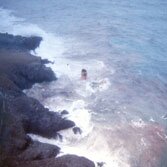BRAER, UK, 1993
5 January 1993

Incident
Following engine failure, BRAER ran aground in severe weather conditions on Garth's Ness, Shetland on 5th January 1993. Over a period of 12 days the entire cargo of 84,700 tonnes of Norwegian Gullfaks crude oil, plus up to 1,500 tonnes of heavy bunker oil, were lost as almost constant storm force winds and heavy seas broke the ship apart. The BRAER spill was very unusual in that a surface slick was not produced. A combination of the light nature of the oil and the exceptionally strong wind and wave energy naturally dispersed the oil throughout the water column. The oil droplets were adsorbed onto sediment particles which eventually sank to the sea bed. Sub-surface currents led to this oil being spread over a very wide area, although a significant portion eventually ended up in two deep, fine sediment 'sinks'.
Response
Contingency arrangements were immediately put in place by the UK government's Marine Pollution Control Unit (MPCU) and the Shetland Islands' Council (SIC) to deal with the oil pollution. Weather conditions prevented the use of mechanical recovery equipment at sea, although about 130 tonnes of chemical dispersant were applied from aircraft during periods when the wind abated slightly and some oil remained on the surface. Oiling of shorelines was minimal relative to the size of the spill and clean-up involved the collection of oily debris and seaweed by a small workforce.
A wide range of fish and shellfish over a fairly large area became contaminated with oil, resulting in the imposition of a Fisheries Exclusion Zone. Farmed salmon held in sea cages in the surface waters within this zone bore the brunt of the contamination since they could not escape the cloud of dispersed oil. Although this contamination was lost quickly once clean water conditions returned, millions of salmon that could not be marketed had to be destroyed. The Exclusion Zone was progressively lifted as fish and shellfish species were found by chemical analysis and taste testing to be free of contamination, although it was still in place over six years after the spill for mussels and Norway lobsters at some sites within the closure area.
A significant amount of oil was blown on to land adjacent to the wreck site. The effects of this airborne oil were localised and had no more than a temporary impact on vegetation and livestock. Seabird casualties were also relatively low. Considering the size of the spill, the environmental impacts were surprisingly limited.
Compensation was agreed by the IOPC Fund.
ITOPF Involvement
ITOPF provided technical advice to the MPCU and acted as adviser to other interested parties including the shipowner, their pollution insurer and the IOPC Fund.
Selected Bibliography
- Davies, J.M. & Topping, G. (editors) (1997). The impact of an oil spill in turbulent waters: The Braer. Proceedings of a symposium held at the Royal Society of Edinburgh, 7-8 September 1995. Stationery Office, Edinburgh, UK
- ESGOSS (1994). The environmental impact of the wreck of the Braer. Scottish Office, Edinburgh, UK
- Marine Pollution Control Unit (1993). The Braer Incident, Shetland Islands, January 1993. HMSO, London, UK
Links
Categories: United Kingdom, Oil, Oil Tanker, Europe
